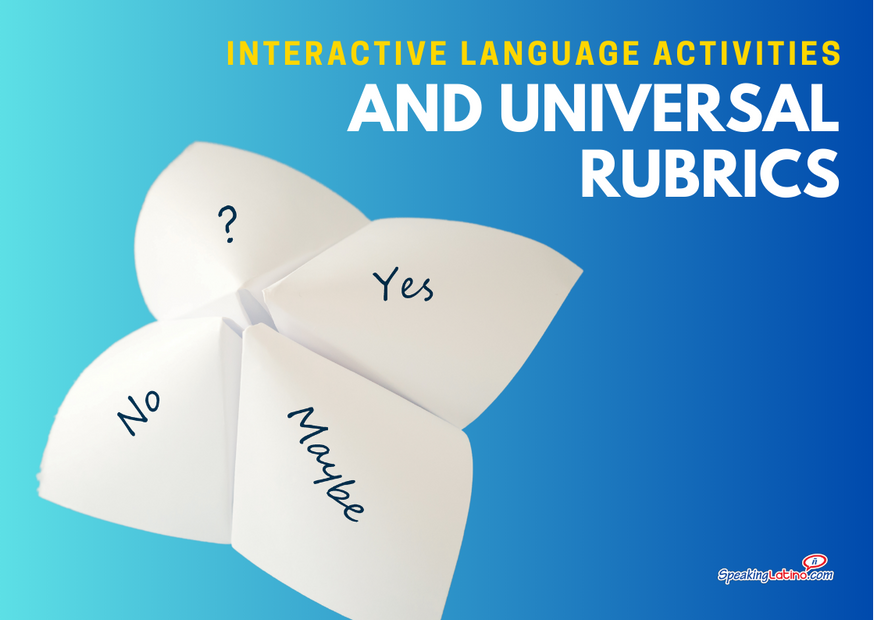
The content of this article is based on the presentation, One & Done by Andrea Nazelli, which was part of the World Language Teacher Summit.
Comprehensive Perspective on Interactive Learning and Universal Rubrics
In language instruction, engaging students in interactive activities is essential for cultivating a dynamic learning environment. The use of well-designed activities and tools can enhance learning outcomes across different proficiency levels.
We'll explore insights into interactive language activities and universal rubrics. Learn about the "Yes, No, Maybe So" activity and its adaptability across age groups, and the incorporation of universal reading and listening rubrics as effective assessment tools.
"Yes, No, Maybe So" Activity: A Versatile Language Learning Tool
The "Yes, No, Maybe So" activity presents a versatile and engaging approach to language instruction. This activity involves creating signs with "yes," "no," and a neutral expression. The minimal preparation required for this activity makes it accessible for educators, with the potential to yield significant engagement and learning outcomes. Emphasizing the adaptability of this activity across student age groups, from preschoolers to advanced learners, makes it a valuable tool for teachers working at varying proficiency levels.
Tailoring Questions for Language Proficiency and Topics
One of the key strategies highlighted is the importance of tailoring the questions or statements in the activity to align with the students' age and the current vocabulary or topic being explored in the class. This personalized approach ensures that the "Yes, No, Maybe So" activity remains relevant and effective in addressing the specific learning needs of the students.
Encouraging Student Engagement and Active Language Use
The interactive nature of the "Yes, No, Maybe So" activity encourages students to share their opinions, engage in conversations, and actively use the target language. This active participation not only reinforces language skills but also fosters a sense of ownership and confidence among the students in expressing their thoughts and opinions in the target language.
Furthermore, using the activity as a listening exercise underscores the activity's multifaceted role in language instruction, reinforcing the importance of effective listening skills in language learning.
Adaptations and Extensions for Diverse Learning Experiences
Providing valuable insights into adapting and extending the "Yes, No, Maybe So" activity to suit a range of classroom scenarios, variations offered showcase the flexibility of this approach. By incorporating technology, such as the use of apps like Flipgrid and Extempore, educators can further enhance the interactive nature of the activity, providing diverse learning experiences for their students.
Universal Reading and Listening Rubrics: Streamlining Assessment
In addition to discussing interactive activities, the concept of universal reading and listening rubrics as powerful assessment tools is presented. The emphasis on using a single copy of each rubric for the entire academic year underscores the efficiency and practicality of these tools. The streamlining of assessment through universal rubrics not only reduces administrative burden for educators but also provides consistent evaluation standards for both reading and listening comprehension at diverse proficiency levels.
Personalization and Differentiation in Assessment
The universal reading and listening rubrics offer a standardized yet adaptable framework for assessing student performance. By clearly defining the benchmarks for different proficiency levels, educators have the opportunity to personalize assessment while ensuring a fair and consistent grading process. This approach aligns with the pedagogical philosophy of emphasizing student understanding and knowledge rather than focusing solely on what may have been overlooked.
Assessment of Language Skills Beyond Comprehension
One noteworthy aspect highlighted is the deliberate choice of having students write in English while being assessed on their reading and listening skills. This decision reflects a nuanced approach to assessment, acknowledging that evaluating language skills extends beyond mere comprehension. The emphasis on writing in the assessment context aligns with the holistic evaluation of language proficiency, recognizing the interconnected nature of different language competencies.

The interactive nature of the "Yes, No, Maybe So" activity encourages students to share their opinions, engage in conversations, and actively use the target language
Variations and Customization for Diverse Educational Levels
The universality of the rubrics does not limit their applicability to a specific educational level. As emphasized, educators can customize the rubrics to suit the needs and proficiency levels of their students. Suggestions for incorporating smiley faces or stars for younger learners and increasing complexity for higher-level learners demonstrate the adaptability of these rubrics. This customization aligns with the guiding philosophy of tailoring educational approaches to the unique learning needs of students.
Implications for Language Instruction
The insights shared hold significant implications for language instruction, particularly in the context of creating engaging and effective learning experiences. The "Yes, No, Maybe So" activity and the universal reading and listening rubrics offer opportunities for educators to reevaluate their pedagogical strategies and assessment methodologies. By integrating interactive activities and streamlined assessment tools, language educators can foster a more dynamic and efficient learning environment.
FAQs About Using Engaging Activities and Rubrics
How can the universal reading and writing rubrics be used in different language learning settings?
The universal reading and writing rubrics can be utilized in various language learning settings to assess and enhance students' language skills. These rubrics provide a standardized framework for evaluating reading comprehension and writing proficiency across different levels of language learners. Here are some ways they can be used:
- Consistent Evaluation: The universal reading and writing rubrics offer a consistent method for evaluating students' performance in reading and writing tasks regardless of their proficiency level or the specific language being learned.
- Adaptability: These rubrics can be adapted to suit the needs of students at different proficiency levels, from novice learners to advanced students. Teachers can adjust the criteria and expectations based on the learners' abilities.
- Feedback: By using these rubrics, teachers can provide constructive feedback to students on their reading and writing skills. The rubrics help students understand the expectations and criteria for success in these language tasks.
- Goal Setting: The rubrics can be used to set clear learning goals for students in terms of reading comprehension and writing proficiency. Students can track their progress and work towards improving their skills based on the rubric criteria.
- Differentiation: Teachers can differentiate instruction by using the rubrics to tailor reading and writing activities to meet the diverse needs of students in the classroom. The rubrics provide a framework for designing tasks that challenge and support learners at different levels.
- Assessment: The rubrics can serve as assessment tools for teachers to measure students' reading and writing abilities over time. They can be used for formative assessment during lessons and summative assessment at the end of units or courses.
- Self-Assessment: Students can also use the rubrics for self-assessment purposes, evaluating their own reading comprehension and writing skills based on the criteria provided. This self-assessment can help students reflect on their strengths and areas for improvement.
In summary, the universal reading and writing rubrics offer a versatile tool for evaluating, guiding, and enhancing students' reading and writing skills in diverse language learning settings.
How can teachers effectively engage students in listening activities in the classroom?
Engaging students in listening activities is crucial for developing their language skills and promoting active participation in the classroom. Here are some strategies that teachers can use to effectively engage students in listening activities:
- Provide Clear Instructions: Start by providing clear and concise instructions for the listening activity to ensure that students understand what is expected of them.
- Set a Purpose: Clearly communicate the purpose of the listening task to students so they know why they are listening and what they should focus on.
- Use Authentic Materials: Incorporate authentic listening materials such as songs, podcasts, news clips, or videos to make the activity more engaging and relevant to real-life situations.
- Interactive Listening: Include interactive listening activities that require students to respond, discuss, or complete tasks based on what they hear. This promotes active engagement and comprehension.
- Pair and Group Work: Encourage pair or group work during listening activities to foster collaboration, peer interaction, and the opportunity for students to discuss and share their understanding.
- Visual Support: Use visual aids, such as images, charts, or videos, to support the listening task and provide context for the audio material.
- Variety of Activities: Incorporate a variety of listening activities, such as gap-filling exercises, multiple-choice questions, dictation, role plays, and comprehension questions, to cater to different learning styles and keep students engaged.
- Provide Feedback: Offer feedback during and after the listening activity to reinforce learning, clarify misunderstandings, and encourage students to reflect on their listening skills.
- Use Technology: Utilize technology tools like audio recording software, online listening platforms, or language learning apps to create interactive and engaging listening tasks.
- Make it Fun: Infuse creativity and fun elements into listening activities through games, storytelling, simulations, or role plays to make the experience enjoyable for students.
By implementing these strategies, teachers can create dynamic and interactive listening activities that captivate students' attention, enhance their listening skills, and promote active engagement in the language learning process.

Encouraging students to share their thoughts and emotions through music enhances language fluency and cultural awareness
What are some variations of the activities that can be adapted for students of all ages and levels?
Adapting activities to suit students of all ages and proficiency levels is essential for creating inclusive and effective language learning experiences. Here are some variations of activities that can be adapted for students of diverse ages and levels:
- Role-Playing: Adjust the complexity and themes of role-playing scenarios to cater to different age groups and language proficiency levels. Younger learners can engage in simple role plays, while older students can tackle more complex scenarios.
- Storytelling: Modify storytelling activities by using age-appropriate content and language complexity. Younger students can create and narrate simple stories, while older learners can delve into more intricate narratives.
- Games and Puzzles: Customize games and puzzles to align with the cognitive abilities and interests of students at various age levels. Adapt the rules, vocabulary, and challenges to suit the target proficiency level.
- Creative Writing: Tailor creative writing tasks to match the writing skills and language proficiency of students. Provide prompts and guidelines that are suitable for different age groups and proficiency levels.
- Listening Activities: Adjust listening activities by selecting audio materials that are engaging and comprehensible for students at different ages and language proficiency levels. Offer varied tasks like gap-filling exercises, comprehension questions, or discussions based on the listening content.
- Visual Aids: Utilize visual aids such as pictures, diagrams, or videos that are age-appropriate and relevant to the language learning objectives. Visuals can support comprehension and engagement across different age groups.
- Collaborative Projects: Organize collaborative projects that allow students to work together on tasks that are adjusted in complexity based on their age and language proficiency. Encourage teamwork and peer support in completing the projects.
- Debates and Discussions: Adapt debates and discussions by selecting topics that are relevant and interesting to students of different ages. Provide guidance and language support tailored to the proficiency level of each group.
- Cultural Activities: Integrate cultural activities that expose students to diverse traditions, customs, and practices suitable for their age group. Encourage exploration and appreciation of different cultures through age-appropriate activities.
- Feedback and Reflection: Implement feedback and reflection sessions that are adapted to the cognitive abilities and language skills of students at various levels. Encourage self-assessment and peer feedback in a manner that is accessible and beneficial to all learners.
By incorporating these variations and adaptations into language learning activities, teachers can create inclusive and engaging experiences that cater to the diverse needs and abilities of students across different ages and proficiency levels.
The Impact of Streamlined Assessment and Interactive Methods on Language Instruction
The "Yes, No, Maybe So" activity and the universal reading and listening rubrics highlights the importance of interactive and personalized language learning experiences.
The adaptability and versatility of the "Yes, No, Maybe So" activity make it a valuable tool for educators working with diverse student populations, while the universal rubrics streamline the assessment process while allowing for personalization and differentiation. It provide language educators with practical strategies to enhance student engagement, foster active language use, and ensure consistent and fair assessment practices, ultimately contributing to more effective language instruction across different proficiency levels.